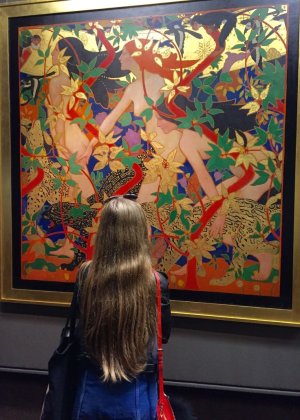stlukesguild
Well-known member
- Messages
- 2,881
Parmigianino was certainly a Mannerist. Art Historians have linked Mannerism to the 1527 "Sack of Rome". Charles V, the Holy Roman Emperor was at war with the Pope, Clement VII. Despite being ordered not to storm the city, the unpaid troops of Charles broke into the city and began looting, killing, and holding citizens for ransom. This resulted in a sense of shock among the citizens of Rome... including the artists not unlike that felt by many following the horrors of WWI which resulted in Dada and other Modernist rejections of the art prior. Mannerism involved a conscious rejection of the standards of High Renaissance Art: symmetry, balance, naturalism, clarity of space, etc... Arguably, Michelangelo's works pointed the way toward Mannerism:


His Medici Tomb dates from 1520-1534. Before 1527, his focus was primarily on the architectural structures of the tomb. Following the sack of Rome in 1527 he shifted his focus to the expressively distorted figures of the tomb.
His figures from the Last Judgment continue to explore such expressive exaggeration.


Even his frescoes on the Sistine Ceiling (completed in 1512) point to Mannerism with his use of "shock color" employing compliments in the shadows (red/green, yellow/purple).

One of the most outrageously comic early Mannerist paintings was that of St. George & the Dragon by Giovanni Antonio Bazzi, known as Il Sodoma.

I can't help think of Monty Python's "killer rabbit" when looking at the pathetic writhing dragon confronted by St. George's candy cane lance and his vicious horse. St. Margaret swoons melodramatically, As pathetic as the dragon seems in this battle, the ground is strewn with arms, feet, and heads.
His Medici Tomb dates from 1520-1534. Before 1527, his focus was primarily on the architectural structures of the tomb. Following the sack of Rome in 1527 he shifted his focus to the expressively distorted figures of the tomb.
His figures from the Last Judgment continue to explore such expressive exaggeration.
Even his frescoes on the Sistine Ceiling (completed in 1512) point to Mannerism with his use of "shock color" employing compliments in the shadows (red/green, yellow/purple).
One of the most outrageously comic early Mannerist paintings was that of St. George & the Dragon by Giovanni Antonio Bazzi, known as Il Sodoma.
I can't help think of Monty Python's "killer rabbit" when looking at the pathetic writhing dragon confronted by St. George's candy cane lance and his vicious horse. St. Margaret swoons melodramatically, As pathetic as the dragon seems in this battle, the ground is strewn with arms, feet, and heads.


